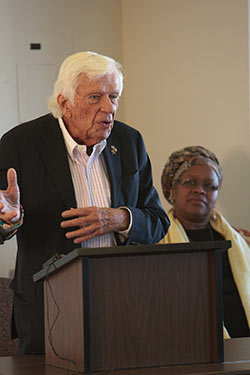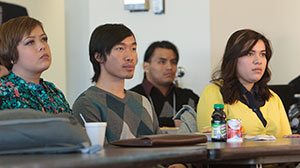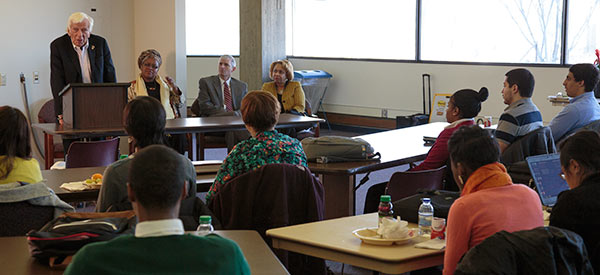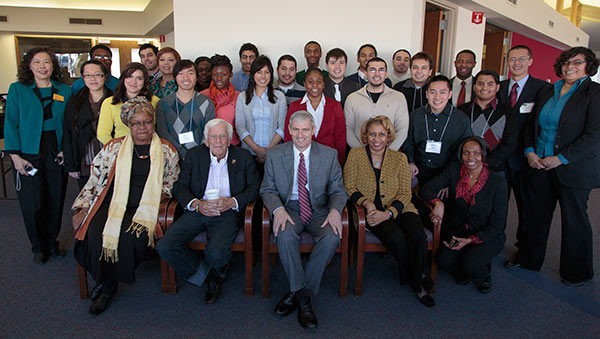Daniel Monge, a senior in physics, used a UWinteriM STEM (Science, Technology, Engineering and Mathematics) “boot camp” as an opportunity to fine-tune a personal statement and work on leadership skills. Eric Vang, a senior in biology, saw it as a chance to network and start planning ahead for research opportunities.
The wooded retreat on Milwaukee’s northwest side where Monge, Vang and other UWM students had a chance to plan for a future in STEM careers has a long history of nurturing innovation and entrepreneurship.

The two-story Cozzens and Cudahy Research Center building once served as the “think tank” for Marquette Electronics, a medical device company founded by Michael J. Cudahy and Warren Cozzens.
After selling Marquette Electronics to GE Healthcare, Cudahy retained ownership of the center, which UWM had leased for the past 10 years. Cudahy, a major philanthropist in Milwaukee, has now donated it to the university.
One of its uses will be as a center for UWM students to conduct research with faculty members and corporate Milwaukee, as well as to discover and explore STEM careers, according to Joan Prince, vice chancellor for global inclusion and engagement. A special emphasis will be placed on recruitment of students who have traditionally been underrepresented in the STEM fields, she noted.
The UWinteriM boot camp, Jan. 7-18, was sponsored by UWM and the Wisconsin Alliance for Minority Participation (WiscAMP) to prepare the 20 students involved for opportunities to participate in undergraduate research and internships locally as well as nationally.
A visit from the founder
Michael J. Cudahy stopped by one morning during the boot camp to visit with students, answer questions, talk a little bit about how he got started in business, relate the history of the building and offer advice on building careers in the STEM fields.
“I started Marquette Electronics in 1965 with $15,000 and a partner,” Cudahy told the students. By the time the firm was sold to GE (in 1998), it was worth three-quarters of a billion. “We just worked hard for 35 years.”
In addition to that hard work, research and development were critical to the success of Marquette Electronics, which focused on medical electronic equipment, he explained. Many of the company’s products grew from ideas born in the Cozzens and Cudahy Center. “I’m feeling a little bit nostalgic,” Cudahy confessed as he looked around the room.
In this building, for example, he told the students, the idea was born for a quadrupole mass spectrometer that eventually flew in space on a joint U.S-Soviet mission.
Passion and determination
 The researchers who worked in the building, he added, had a passion for what they were doing and a determination to make products work. Those are essential qualities for entrepreneurs and innovators in the STEM fields. They also need to search out ideas for products that are needed.
The researchers who worked in the building, he added, had a passion for what they were doing and a determination to make products work. Those are essential qualities for entrepreneurs and innovators in the STEM fields. They also need to search out ideas for products that are needed.
Cudahy and Cozzens took a chance on their company’s first major product, a centralized ECG (electrocardiograph) system they developed for Northwestern University Medical School.
“Take some calculated risks and have some fun with it,” he advised the students.
Both Cudahy and UWM Chancellor Michael R. Lovell, who also attended the Jan. 17 event, expressed the importance of developing researchers and scientists who are innovative and entrepreneurial. “The things that happened here were remarkable,” said Lovell.
Lovell noted that the U.S. has a great need for graduates in the STEM fields, and that universities need to encourage and nurture more students to explore careers in these areas. “If we just wait for students to appear, we are never going to have enough students in the pipeline.”
Supplying the STEM pipeline
“This will be a place of STEM innovation for the STEM pipeline,” said Prince. “It will be a place for hands-on learning, tutoring and mentoring for high-school and undergraduate college students. These students will be taught by graduate STEM students and UWM STEM faculty. In turn, our undergraduate and graduate students will be mentored by faculty and researchers from the corporate community.”
The boot camp, which involved first-year through senior students, was designed to help students build a resume/CV, develop a statement of purpose for future internship and research opportunities, work with mentors and explore career opportunities in the STEM fields. It also gave them a chance to work together on a team-based challenge to build a device, using Legos, that solved a real-world problem.
For Tommy Lloyd, a first-year student in civil engineering, the boot camp was a chance to find out more about what researchers and engineers at places like GE Healthcare actually do on the job.
“The STEM boot camp helped me find great opportunities at the entry level,” says Jason Martinez, an actuarial science major. “It’s generated a pathway to higher-level research.
Mawata Sheriff, a freshman in microbiology, would like to go on to graduate school, and eventually into research. The UWinteriM WiscAMP program gave her an opportunity to start developing her own research interests and make connections with faculty.
She also enjoyed learning about the history of the center. “I liked hearing his [Cudahy’s] stories and the impact of the products the company developed. He was very humble and passionate about what he did.”








